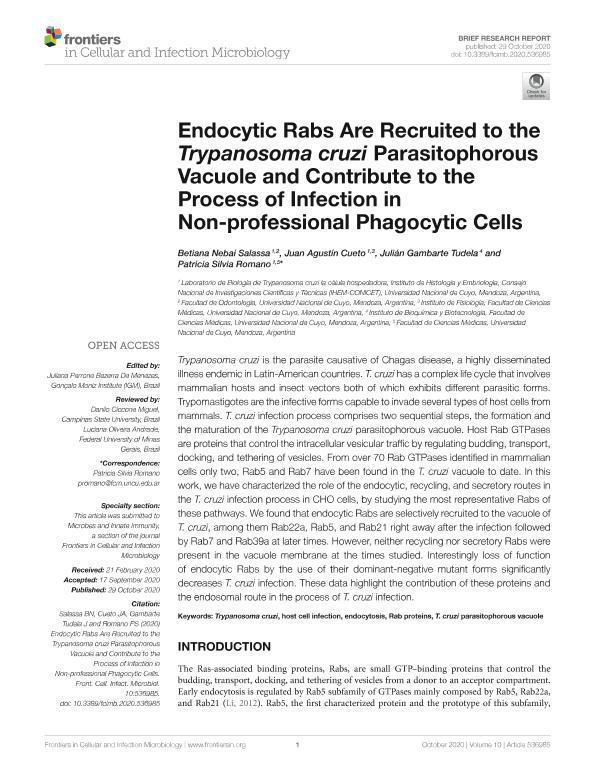Mostrar el registro sencillo del ítem
dc.contributor.author
Salassa, Betiana Nebaí

dc.contributor.author
Cueto, Juan Agustin

dc.contributor.author
Gambarte Tudela, Julian Alberto

dc.contributor.author
Romano, Patricia Silvia

dc.date.available
2021-09-23T14:54:51Z
dc.date.issued
2020-10
dc.identifier.citation
Salassa, Betiana Nebaí; Cueto, Juan Agustin; Gambarte Tudela, Julian Alberto; Romano, Patricia Silvia; Endocytic Rabs Are Recruited to the Trypanosoma cruzi Parasitophorous Vacuole and Contribute to the Process of Infection in Non-professional Phagocytic Cells; Frontiers Media S.A.; Frontiers in Cellular and Infection Microbiology; 10; 10-2020; 1-9
dc.identifier.issn
2235-2988
dc.identifier.uri
http://hdl.handle.net/11336/141351
dc.description.abstract
Trypanosoma cruzi is the parasite causative of Chagas disease, a highly disseminated illness endemic in Latin-American countries. T. cruzi has a complex life cycle that involves mammalian hosts and insect vectors both of which exhibits different parasitic forms. Trypomastigotes are the infective forms capable to invade several types of host cells from mammals. T. cruzi infection process comprises two sequential steps, the formation and the maturation of the Trypanosoma cruzi parasitophorous vacuole. Host Rab GTPases are proteins that control the intracellular vesicular traffic by regulating budding, transport, docking, and tethering of vesicles. From over 70 Rab GTPases identified in mammalian cells only two, Rab5 and Rab7 have been found in the T. cruzi vacuole to date. In this work, we have characterized the role of the endocytic, recycling, and secretory routes in the T. cruzi infection process in CHO cells, by studying the most representative Rabs of these pathways. We found that endocytic Rabs are selectively recruited to the vacuole of T. cruzi, among them Rab22a, Rab5, and Rab21 right away after the infection followed by Rab7 and Rab39a at later times. However, neither recycling nor secretory Rabs were present in the vacuole membrane at the times studied. Interestingly loss of function of endocytic Rabs by the use of their dominant-negative mutant forms significantly decreases T. cruzi infection. These data highlight the contribution of these proteins and the endosomal route in the process of T. cruzi infection.
dc.format
application/pdf
dc.language.iso
eng
dc.publisher
Frontiers Media S.A.

dc.rights
info:eu-repo/semantics/openAccess
dc.rights.uri
https://creativecommons.org/licenses/by/2.5/ar/
dc.subject
ENDOCYTOSIS
dc.subject
HOST CELL INFECTION
dc.subject
RAB PROTEINS
dc.subject
T. CRUZI PARASITOPHOROUS VACUOLE
dc.subject
TRYPANOSOMA CRUZI
dc.subject.classification
Biología Celular, Microbiología

dc.subject.classification
Ciencias Biológicas

dc.subject.classification
CIENCIAS NATURALES Y EXACTAS

dc.title
Endocytic Rabs Are Recruited to the Trypanosoma cruzi Parasitophorous Vacuole and Contribute to the Process of Infection in Non-professional Phagocytic Cells
dc.type
info:eu-repo/semantics/article
dc.type
info:ar-repo/semantics/artículo
dc.type
info:eu-repo/semantics/publishedVersion
dc.date.updated
2021-09-06T19:58:17Z
dc.journal.volume
10
dc.journal.pagination
1-9
dc.journal.pais
Suiza

dc.description.fil
Fil: Salassa, Betiana Nebaí. Consejo Nacional de Investigaciones Científicas y Técnicas. Centro Científico Tecnológico Conicet - Mendoza. Instituto de Histología y Embriología de Mendoza Dr. Mario H. Burgos. Universidad Nacional de Cuyo. Facultad de Ciencias Médicas. Instituto de Histología y Embriología de Mendoza Dr. Mario H. Burgos; Argentina. Universidad Nacional de Cuyo. Facultad de Odontologia; Argentina
dc.description.fil
Fil: Cueto, Juan Agustin. Consejo Nacional de Investigaciones Científicas y Técnicas. Centro Científico Tecnológico Conicet - Mendoza. Instituto de Histología y Embriología de Mendoza Dr. Mario H. Burgos. Universidad Nacional de Cuyo. Facultad de Ciencias Médicas. Instituto de Histología y Embriología de Mendoza Dr. Mario H. Burgos; Argentina. Universidad Nacional de Cuyo. Facultad de Ciencias Médicas. Instituto de Fisiología; Argentina
dc.description.fil
Fil: Gambarte Tudela, Julian Alberto. Universidad Nacional de Cuyo; Argentina. Consejo Nacional de Investigaciones Científicas y Técnicas; Argentina
dc.description.fil
Fil: Romano, Patricia Silvia. Consejo Nacional de Investigaciones Científicas y Técnicas. Centro Científico Tecnológico Conicet - Mendoza. Instituto de Histología y Embriología de Mendoza Dr. Mario H. Burgos. Universidad Nacional de Cuyo. Facultad de Ciencias Médicas. Instituto de Histología y Embriología de Mendoza Dr. Mario H. Burgos; Argentina
dc.journal.title
Frontiers in Cellular and Infection Microbiology
dc.relation.alternativeid
info:eu-repo/semantics/altIdentifier/url/https://www.frontiersin.org/articles/10.3389/fcimb.2020.536985/full
dc.relation.alternativeid
info:eu-repo/semantics/altIdentifier/doi/http://dx.doi.org/10.3389/fcimb.2020.536985
Archivos asociados
